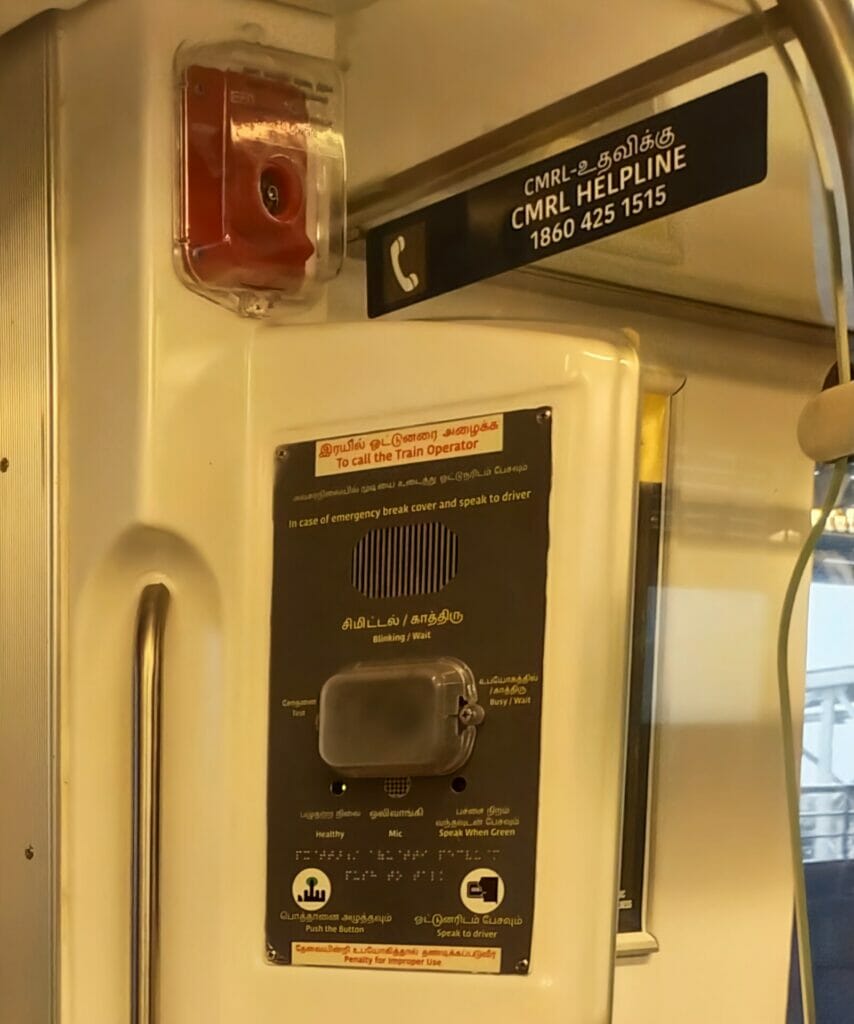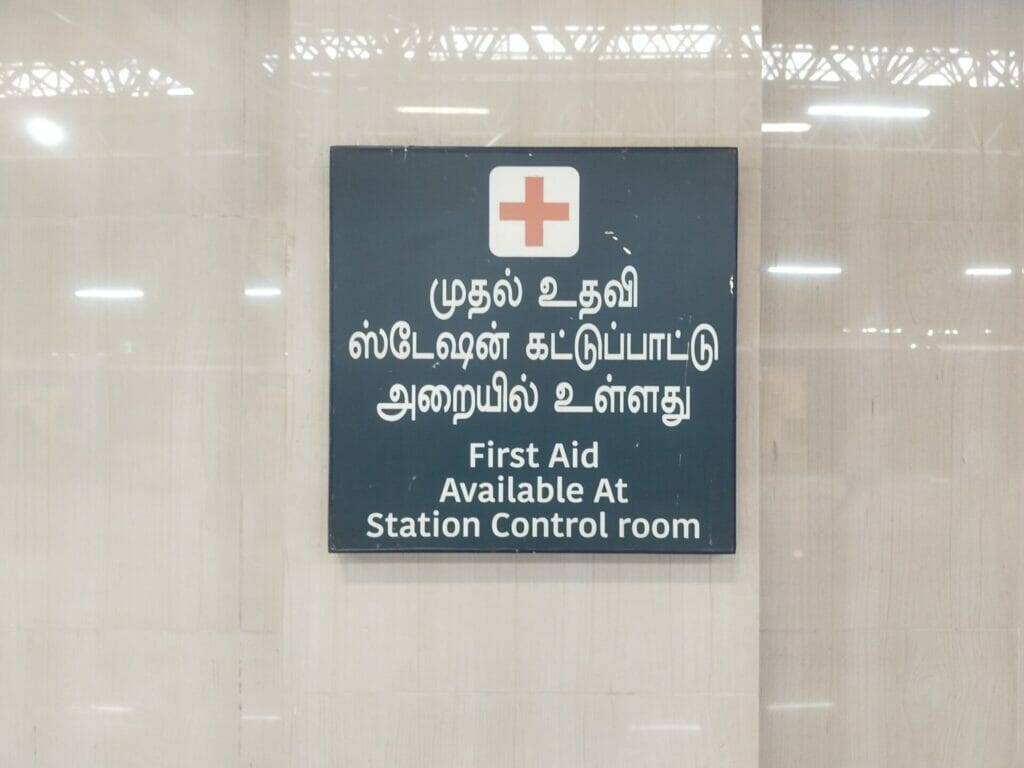Savitha, a resident of Thirumangalam, travels to Guindy every day by Chennai metro. Last December, when Savitha was walking out of the Thirumangalam metro station, she found the floor of the station wet due to the rain. She slipped and fell, and sustained minor injuries as a result. “I did not know if there were any first aid facilities available at the station. Besides, there were no staff at the place where I fell. So, I walked out of the station and went to the nearby medical shop to get some first aid,” she says.
Similar instances have also been reported, especially during the monsoon season, by a few senior citizens who are regular users of Chennai metro rail services.
But not all medical emergencies have a quick fix. Some instances can turn out to have much more serious consequences. Examples from other metro cities show that lack of medical response during the golden hour at the metro stations has even led to fatalities.
In one such instance, 67-year-old Thimmegowda suffered a heart attack while he was riding the Bengaluru metro and died as he did not get the required medical assistance during the golden hour.
Taking suo moto cognisance of the requirement of basic life support systems at various public places, the Delhi High Court directed the Delhi Metro Rail Corporation to explore setting up cardiac support facilities at the major interchange stations.
With many people switching to metro trains due to the bad shape of roads and bottleneck traffic, the Chennai Metro Rail Limited (CMRL) has recorded an increase in passenger footfall. According to news reports, as many as 72.68 lakh passengers travelled in Chennai metro trains in May this year.
With lakhs of people travelling in the metro trains, the metro stations in Chennai should also be well equipped to handle medical emergency cases.
Despite being the preferred mode of public transport for many, the case with the Chennai metro is that almost every passenger I spoke to had no clue about what kind of medical help is available at the metro stations in Chennai.
Read more: Koyambedu bus stand must take steps to improve preparedness to face medical emergencies
The need for more information and awareness
“I once slipped and fell down at the metro station when I was about to step out of the escalator. The commuters at the station rushed to help. Luckily, I did not sustain any injury. However, given that such instances tend to happen, especially during peak hours when everybody is in a rush and there is considerable footfall at the metro stations, the CMRL should take steps to create awareness on the available medical emergency facilities,” says Srinivasan, a 58-year-old resident of Alandur.
Srinivasan further adds that having wheelchairs at accessible points inside the metro stations will not only help persons with disabilities and senior citizens but also those who are facing medical emergencies inside the metro stations.
When we asked many metro users if they were aware of the medical emergency facilities at the Chennai metro stations, they all unanimously replied in the negative.
“The metro staff might know about it but I am not aware of a medical facility inside the metro stations,” says Shankari*, a shopkeeper at a metro station.
“I have neither heard of any such facilities at the metro stations nor have I seen the display of boards that has the information on the available medical emergency facilities in metro stations,” says Dayanand Krishnan, a GIS consultant based in Chennai who travels regularly by the Chennai metro.
Dayanand emphasises that having the facility to attend to medical emergencies at metro stations is important. “There should be a permanent medical team deployed at the metro stations to attend to medical emergency cases. Even if the medical teams are not available in all the stations, CMRL should provide details on where the nearest medical teams are stationed and how they can be reached when needed,” he says.

He further adds that an exclusive helpline number should also be provided for the public to contact in cases of medical emergencies. “Such information on available medical facilities and helpline numbers should be set for display in prominent places such as ticket counters. The helpline numbers should also be displayed in a prominent colour inside the trains. CMRL should also station exclusive ambulances to attend to the passengers in need,” he says.
During a spot check of a few metro stations, the only signboard I found was at the Alandur metro station that read first aid facilities are available at the station control. This signage too was to the side of the platform where not many passengers would notice or pass by it.
Read more: Facing a medical emergency in Chennai railway stations? Here is what you should know
Building walls around urgent information
Since the information on the available medical emergency facilities at the metro stations in Chennai was not available anywhere in the metro stations, I approached the CMRL staff at various stations. All of them told me that they were not allowed to interact with media persons and asked me to talk to the station controller instead.
The station controllers also said the same. “We are not allowed to talk to media directly. Please get a letter from the head office of CMRL at Nandhanam seeking the information you need and then we will talk.”
During a preliminary visit to the head office of CMRL on July 10th, I was told at first to email the questions to the Public Relations Officer (PRO) Girirajan, and then fix an appointment to meet with him to get the required information. I mailed him the questions on July 12th to which I have received no acknowledgement, let alone a response, to this day.
Since then, almost every other day, I have followed up to get an appointment with the PRO. After nearly 42 days of consistent follow-up and a reminder email on August 17th, I secured an appointment with the PRO for a meeting on August 21st.
When I visited the CMRL head office in Nandanam again on the specified date, I was informed that the PRO was on leave and I would have to reschedule the appointment and follow up with his assistants later in the week.
Authorities informed me that all other officials were busy and there was no one who could give me the simple but critical piece of information I needed: What should a passenger do if they face or see someone in need of urgent medical attention? How were staff at the station trained or equipped to meet such situations?
There have been news reports in the past describing how the CMRL staff helped the passengers during a medical emergency. Such news reports appear to indicate that the metro stations do in fact have facilities for first aid, and perhaps other more serious assistance too.
Clearly, however, the CMRL does not consider it important to share that information publicly, despite it being a simple move that could go a long way in reassuring commuters and also ensuring effective emergency response.
What bystanders can do in case of medical emergencies
“Irrespective of what is the next best available medical facility be it the availability of a clinic or an ambulance, the critical first few minutes influence the patient’s survival. It can be an emergency as simple as someone having a fall or a cardiac arrest. There is a scope for the layperson, who is around the patient when they face such an emergency, to do the right few things that will have a major impact on their survival. Even if it is not a life-threatening emergency, this immediate response will have an impact on how soon the person can come back to normal,” says Rajesh R Trivedi, the Co-Founder and Managing Trustee of Alert, a not-for-profit organization working to ensure the ‘Right to Life’ a reality in India by bettering the emergency response ecosystem.
“It starts from the ability to read the emergency scene where one knows if the medical emergency of the person suffering is life-threatening or not and how much time they have before the professional help arrives. With that knowledge, they can do a range of help from tying a bandage if someone is bleeding or putting a person in a simple recovery position depending on the case-to-case basis. Any layperson can do this and it does not require a paramedic or a doctor,” adds Rajesh.
Many people have the hesitation to come forward to help people primarily for two reasons. First is the lack of confidence that arises because of a lack of awareness of the first response. Second, is the inhibition that arises out of fear of dealing with the police or court at a later point in time if something goes wrong.
There is something called a Good Samaritan Law which protects the citizens who come forward with good intentions to help during such emergency situations. It clearly gives total protection from the police, the provisions to not disclose the identity, and free from any civil or criminal liability even if something goes wrong.
Awareness of these laws will help the common person to come forward with more confidence to help those in need of help during medical emergencies. However, it also requires proper awareness of the fundamentals of first responses.
Things to consider during a medical emergency:
Are you dealing with a victim who is conscious or unconscious? A simple way to ascertain this is by tapping the shoulders of the victim and shouting something loud. This will help to see if the person responds to stimuli of touch or sound. If there is a response from the person, then they are in a less life-threatening situation but you have to be around to keep them engaged.
If someone collapses, the first respondent should check if the person is breathing or not. A quick way to check whether the person is breathing or not is by placing a tissue paper (though unscientific, it is an easy way) near the nose or by placing two fingers near the nose.
If the person is breathing, then the immediate thing to do is to put them in a recovery position In a layperson’s terms, it is to put the person in a sideways sleeping position without a pillow. This is extremely helpful in dealing with patients who are breathing but are unconscious. Irrespective of the cause of unconsciousness, the recovery position helps to get the blood to the brain. many a time, when the person is put in a recovery position for five to seven minutes, they will come around immediately.
Another common mistake that we tend to make is to provide the unconscious person with water, soda or juice. If a person is unconscious and is not responding to basic stimuli, do not offer anything to drink (even water). That will only aggravate the situation. When a person is unconscious and is not in a position to swallow their own saliva, it means that the food pipe is closed and the windpipe is open. When we offer water, soda or any such liquid, the chances of it getting into the person’s lungs are higher. This is something we all should be completely aware of ‘what not to do’ when a person is unconscious.
Alert also provides a basic program online on first response during medical emergencies every Saturday which is free for anyone to join – https://alert.ngo/savioursaturdays/
They also have YouTube videos of some of the basic first responses that we should be aware of – https://youtube.com/playlist?list=PL0IvZh9fuI9ToFWFbDbz849-uCKQAzZ-K
We invite readers to share their experiences of facing a medical emergency in a metro station in Chennai and what they would like the CMRL to do in such instances. Please send in your thoughts to chennai@citizenmatters.in.

Interesting article. I especially liked the section on ‘What bystanders can do in case of medical emergencies.’